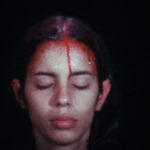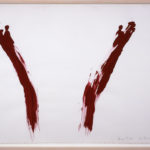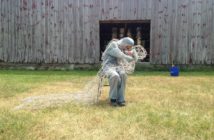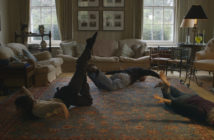Ana Mendieta (1948-1985) wasn’t the first, nor will she be the last female artist to use her own body, feminine processes, and the stuff of the earth in her art—of her generation, Judy Chicago and Kiki Smith immediately come to mind. But when I viewed Mendieta’s work at the Rose Museum at Brandeis University recently, it wasn’t these artists I thought of, but a novelist.
At a time when women were reevaluating their place after the free love movement of the 1960s, Marilyn French’s 1977 novel The Women’s Room became a life buoy to this generation, my mother included. When I read The Women’s Room as an adult, I was attempting to understand the historical scope of feminism for mothers in particular. What was my lineage as an artist-mother? Why was it so difficult for my mother to realize her own artistic ambitions?
French’s novel spoke mostly to the emerging middle class, but the issues for women were universal: as the novel’s narrator says, “…there are so much easier ways to destroy a woman. You don't have to rape or kill her; you don't even have to beat her. You can just marry her."
Mendieta was newly married, 36 years old, when she fell from a New York apartment window. What isn’t known is whether she jumped, fell, or was pushed, and the truth remains elusive to this day. Mendieta’s husband, the artist Carl Andre, was tried and acquitted, but many continue to question his innocence.
Had she lived, would Mendieta have taken a back seat to Andre’s fame? Or, conversely, would he have been able to tolerate hers? We can’t know the answers to either of these questions, of course; but even in death Mendieta continues to grow in stature as a potent truth teller who explored the visceral beauty of the feminine as an aspect rather than an identity. Mendieta understood implicitly that the feminine is at the core of all generative processes, and is, by definition, life-giving. Through the use of her own body and the earth itself, she beautifully connected the two.
In much of her performance art, Mendieta’s physical body was the canvas upon which she applied the substances of life and death—animal blood, chicken feathers, mud, leaves. In the chaos of post-revolutionary Cuba, Mendieta was sent to live in America at the age of 12, and she continued to draw from a Santeria tradition that involved the use of animal blood as part of its rituals. To Mendieta, using blood in her work was not meant to shock; it was a legitimate means of speaking.
In the Rose exhibition, which consists simply of a triptych of paintings and a single film of less than four minutes, Mendieta went beyond the stereotypical notion of the angry feminist into something far deeper: literally, the recesses of the earth, and of life itself—blood being its most potent manifestation. While there was much to be angry about—and certainly, she and other feminist artists of the time created from that place of anger—Mendieta’s work, although sometimes hard to view, was meant to probe and even celebrate. And yet Mendieta did interrogate the darker spaces of male violence against women. In doing so, along with other artists and writers such as Smith, Chicago and French, she brought to light the mistrust, even hatred, of the feminine in the broader and at times unconscious sense.
Mendieta’s triptych Body Tracks (1982, blood and tempera paint on paper), asks us to face what we know—that we are composed of a life force that is at once powerful and fragile, and so easily destroyed. In each of the images, which, on first glance, are simply smears of blood writ large on the paper, a closer view reveals much more; perhaps more than Mendieta herself intended.
In the first of the three paintings (the result of a performance piece at Franklin Furnace in New York City), where Mendieta’s hand first meets the surface, the mark of her fingers appeared to me as the image of a woman, head bowed to a smaller figure below; a child? The Rorschach-like mirroring in each of the three paintings is similar but not exact, allowing for much interpretation through one’s personal filter. Of course I would see a mother and children.
Mendieta’s film, Sweating Blood (1973, Super-8mm film transferred to high-definition digital media; color, silent; 3:18 min), was harder to see: Mendieta is still, eyes closed, her black hair merging with the dark background as blood beads slowly from her pores and then slowly runs from her hairline. (The effect was achieved through the use of a syringe and simple editing techniques.) While the illusion was unnerving, here I felt the strongest connection: As a woman who in many ways has fulfilled the culturally expected roles of my sex, I have felt this sensation—that I had to bleed out all of the burdens I carried within, even if I was lucky enough to do so willingly. It is not enough to give birth; the feminine requires a constant series of births.
Mendieta may or may not have been pushed to her death by her husband, but the irony of her brutal end is inescapable. Mendieta pushed her own consciousness to face its origins and invited us to meet her there and see our own.
Rose Video 10: Ana Mendieta was on view through June 11 in the Rose Video Gallery at Rose Art Museum, Brandeis University. Visit www.brandeis.edu/rose for more information.
- Ana Mendieta, Sweating Blood, 1973 (video still). © The Estate of Ana Mendieta Collection, LLC. Courtesy Galerie Lelong, New York
- Ana Mendieta, Sweating Blood, 1973 (video still). © The Estate of Ana Mendieta Collection, LLC. Courtesy Galerie Lelong, New York
- Ana Mendieta, Sweating Blood, 1973 (video still). © The Estate of Ana Mendieta Collection, LLC. Courtesy Galerie Lelong, New York
- Ana Mendieta, Body Tracks, 1982. Rose Art Museum, Brandeis University_ Rose Purchase Fund. © The Estate of Ana Mendieta Collection, LLC. Courtesy Galerie Lelong, New York








